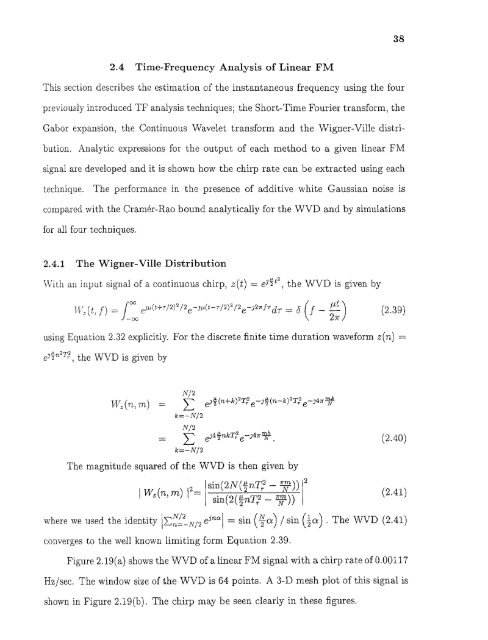Space/time/frequency methods in adaptive radar - New Jersey ...
Space/time/frequency methods in adaptive radar - New Jersey ...
Space/time/frequency methods in adaptive radar - New Jersey ...
You also want an ePaper? Increase the reach of your titles
YUMPU automatically turns print PDFs into web optimized ePapers that Google loves.
382.4 Time-Frequency Analysis of L<strong>in</strong>ear FMThis section describes the estimation of the <strong>in</strong>stantaneous <strong>frequency</strong> us<strong>in</strong>g the fourpreviously <strong>in</strong>troduced TF analysis techniques; the Short-Time Fourier transform, theGabor expansion, the Cont<strong>in</strong>uous Wavelet transform and the Wigner-Ville distribution.Analytic expressions for the output of each method to a given l<strong>in</strong>ear FMsignal are developed and it is shown how the chirp rate can be extracted us<strong>in</strong>g eachtechnique. The performance <strong>in</strong> the presence of additive white Gaussian noise iscompared with the Cramér-Rao bound analytically for the WVD and by simulationsfor all four techniques.2.4.1 The Wigner-Ville Distributionthe WVD is given byus<strong>in</strong>g Equation 2.32 explicitly. For the discrete f<strong>in</strong>ite <strong>time</strong> duration waveform z(n)..a n2T2eJ2 , the WVD is given byThe magnitude squared of the WVD is then given byconverges to the well known limit<strong>in</strong>g form Equation 2.39.Figure 2.19(a) shows the WVD of a l<strong>in</strong>ear FM signal with a chirp rate of 0.00117Hz/sec. The w<strong>in</strong>dow size of the WVD is 64 po<strong>in</strong>ts. A 3-D mesh plot of this signal isshown <strong>in</strong> Figure 2.19(b). The chirp may be seen clearly <strong>in</strong> these figures.
















